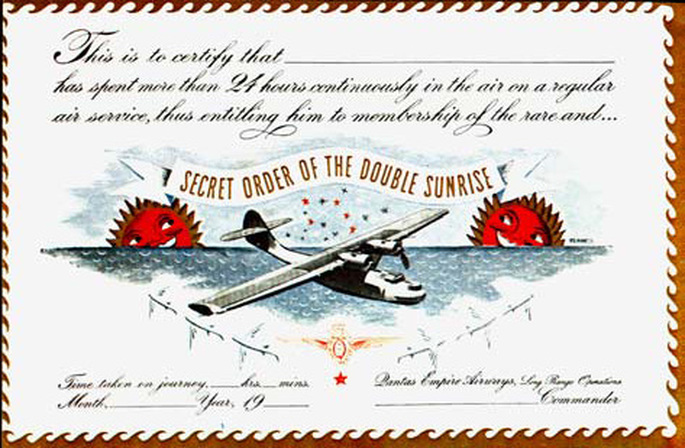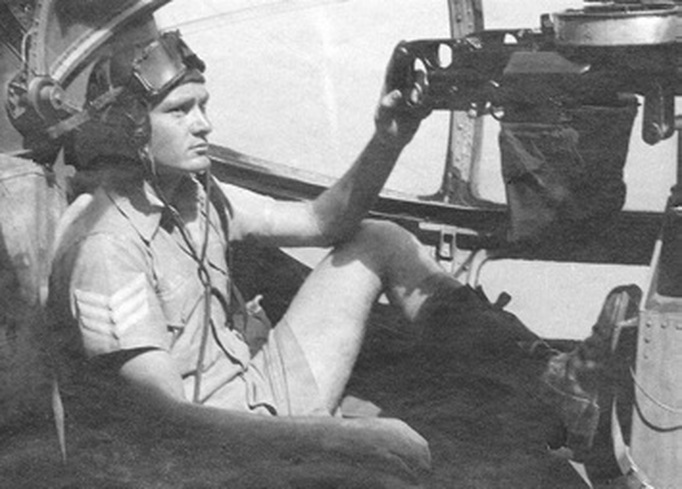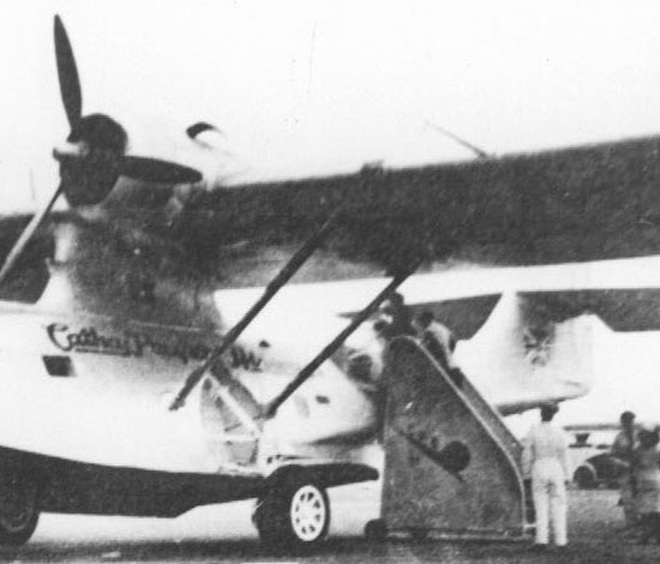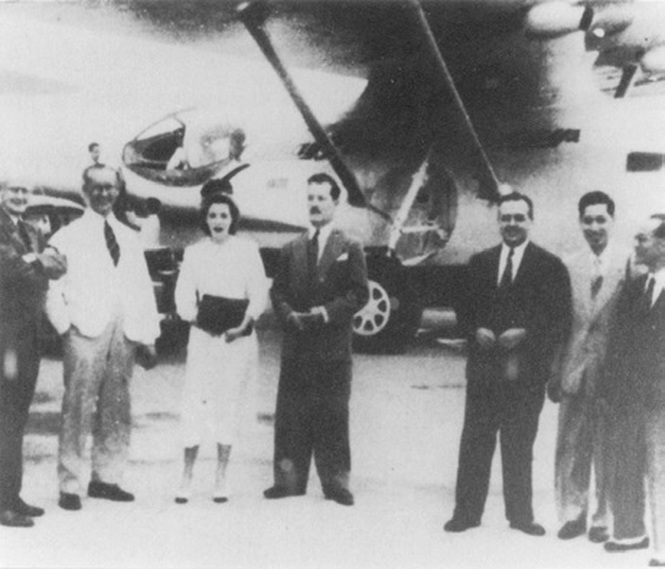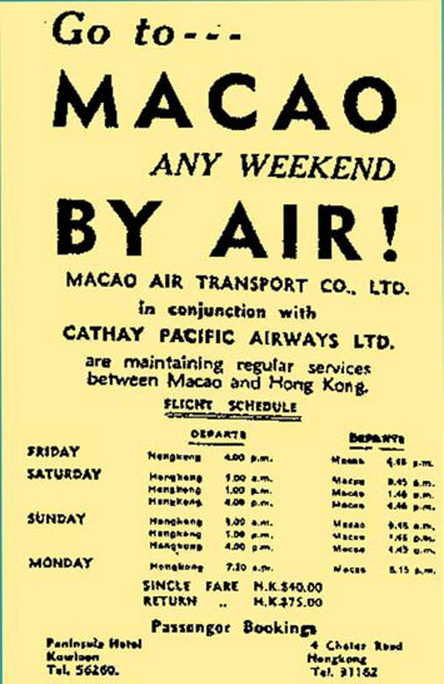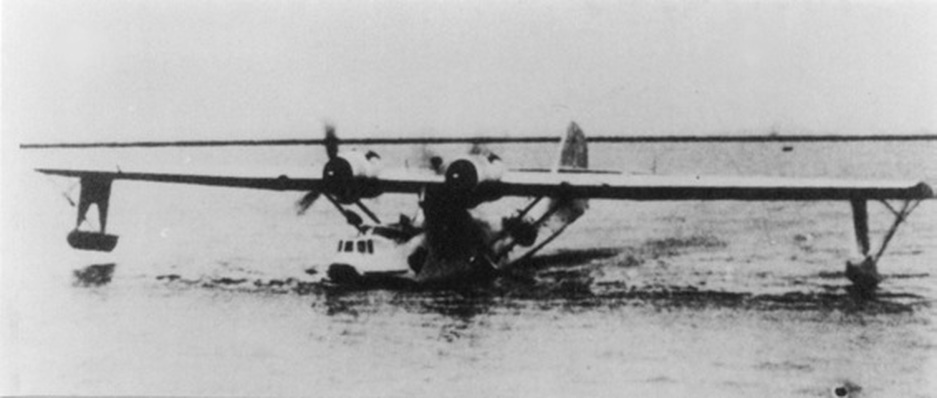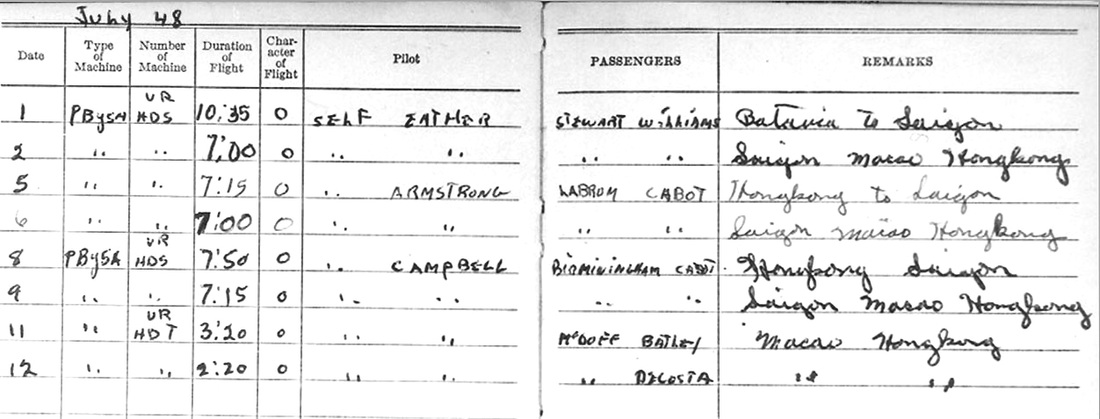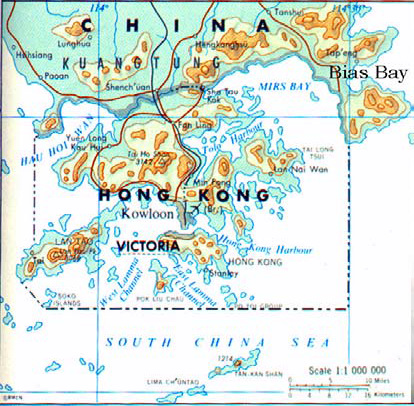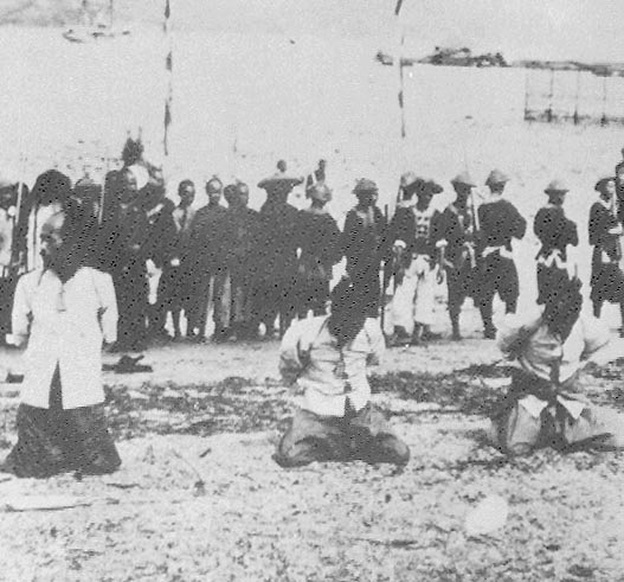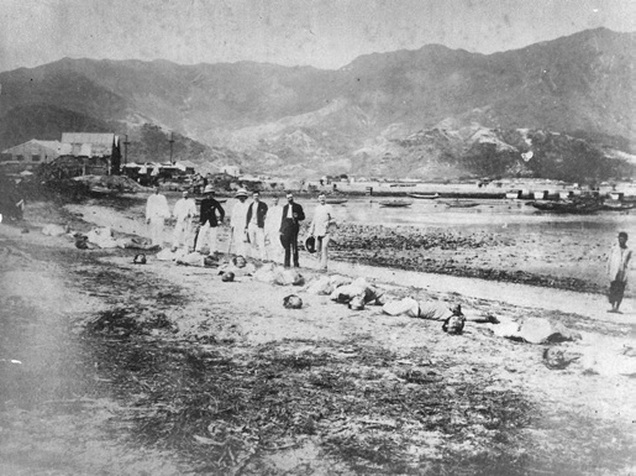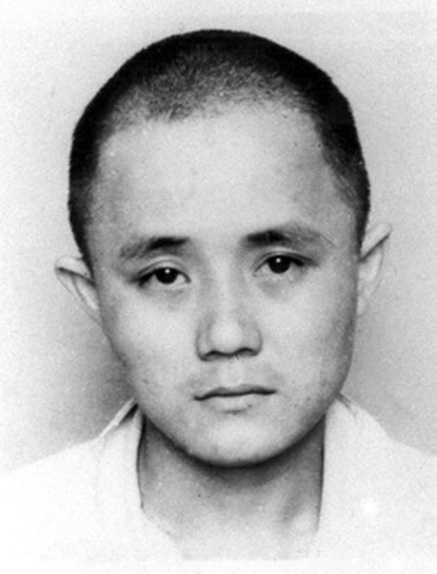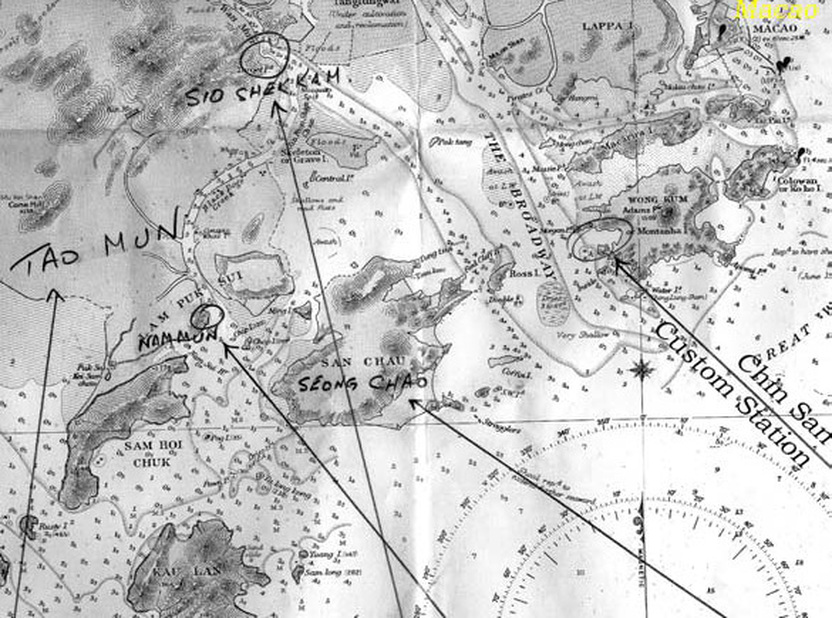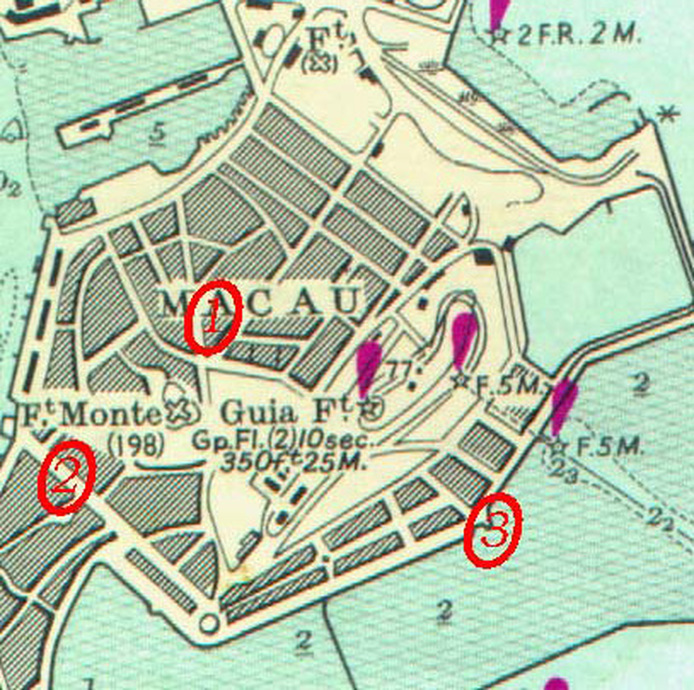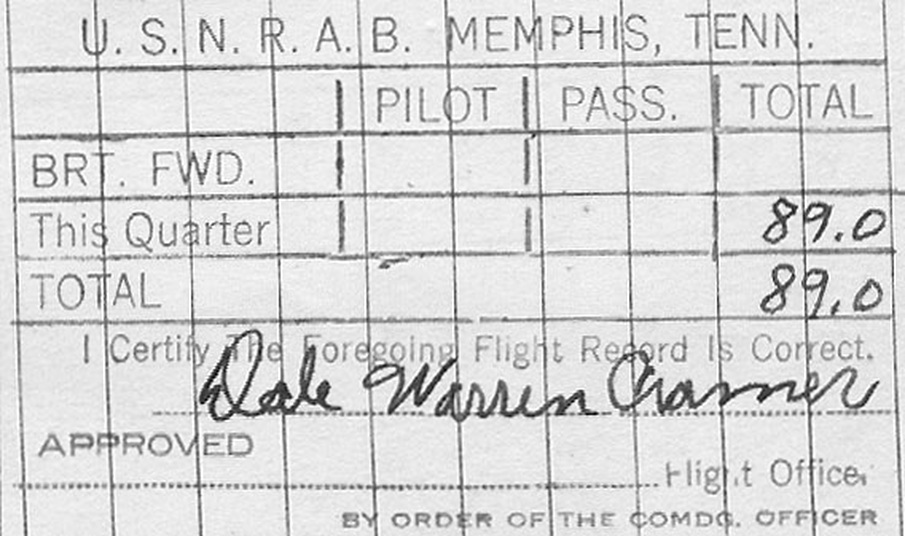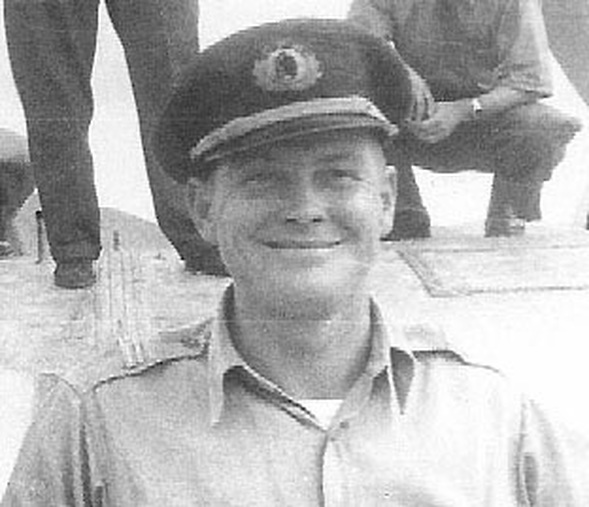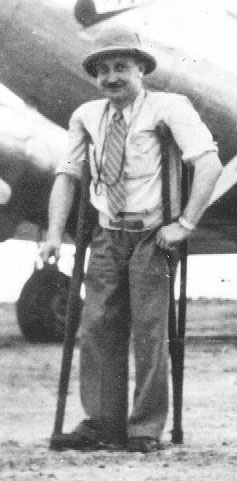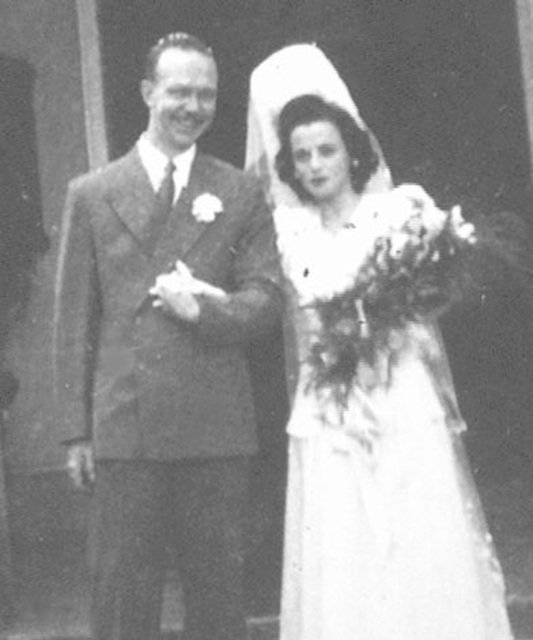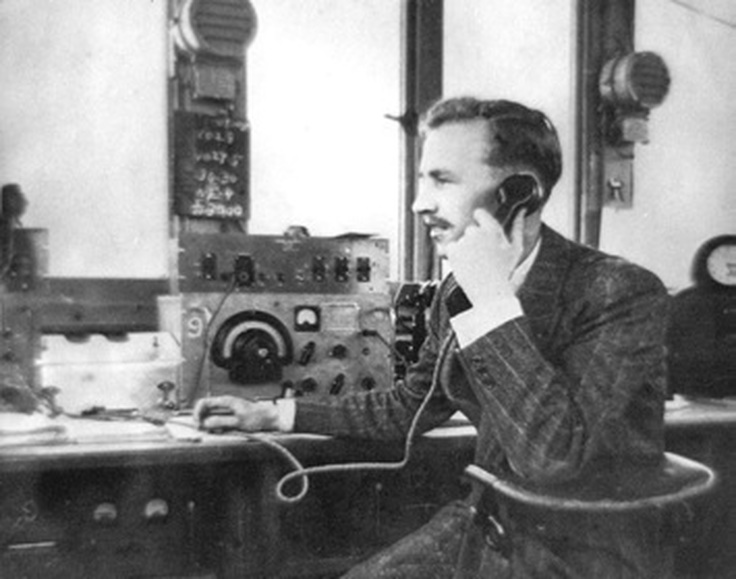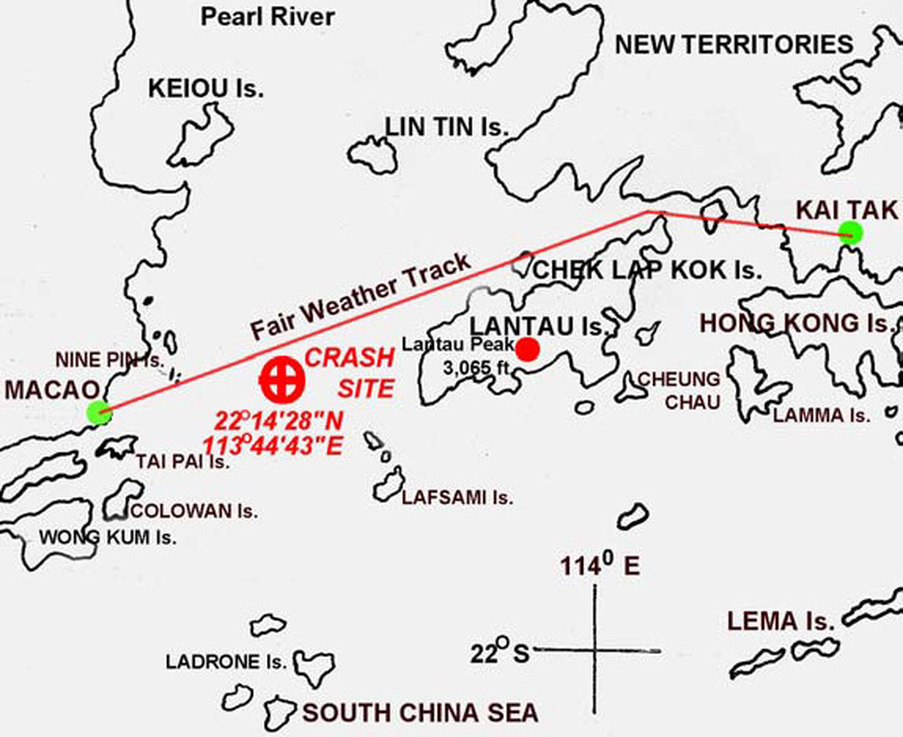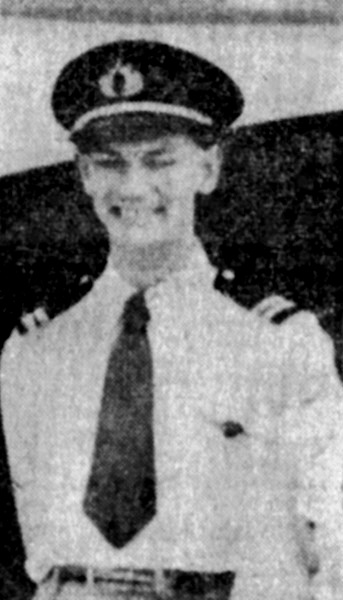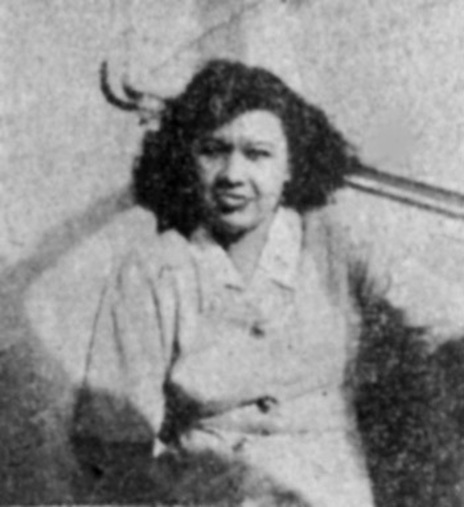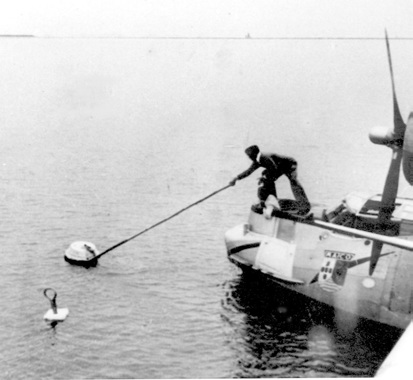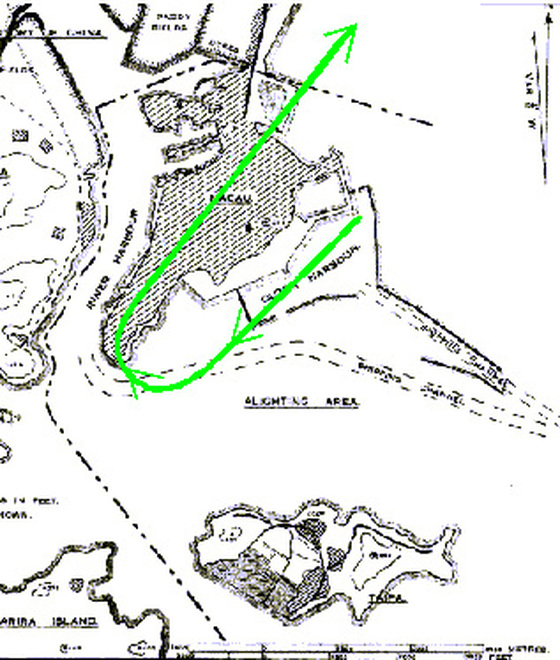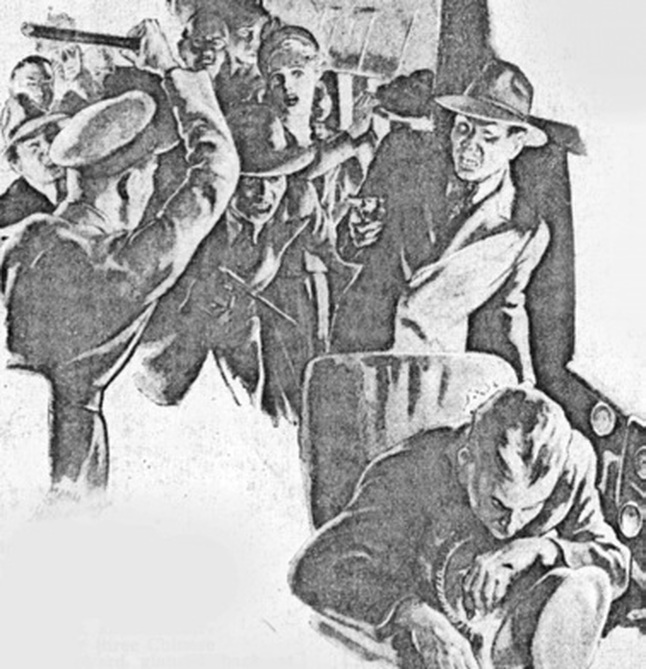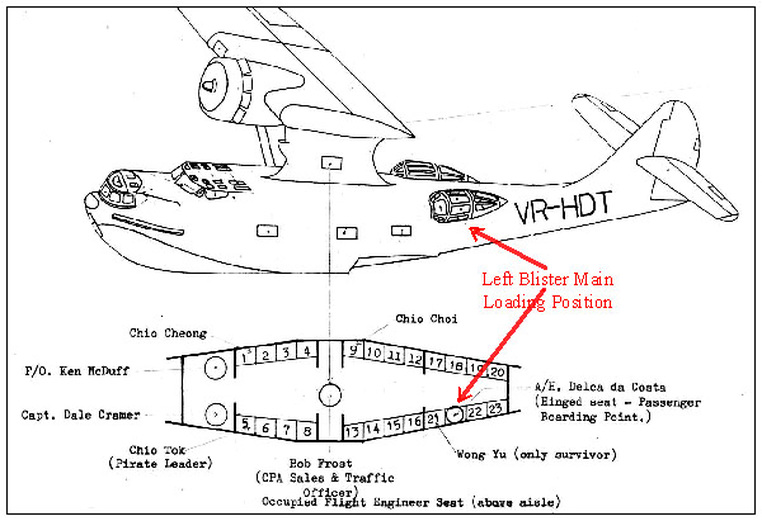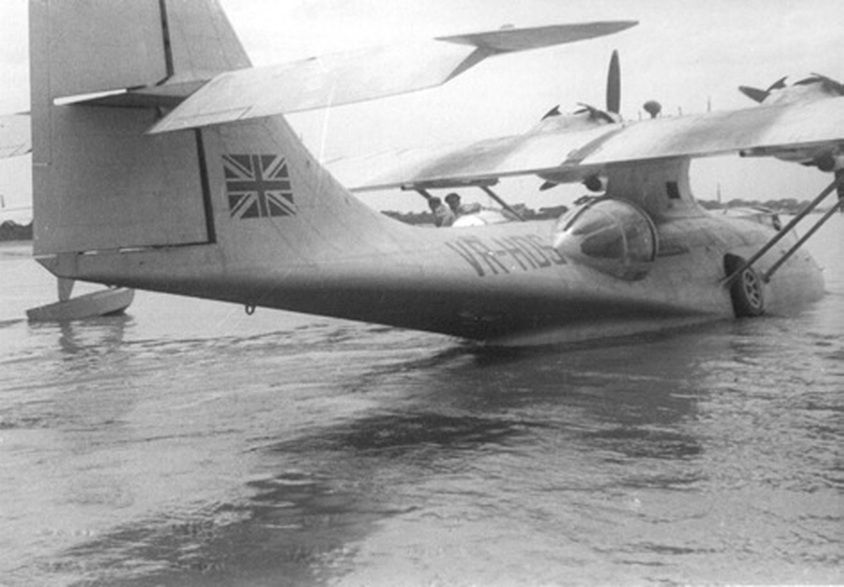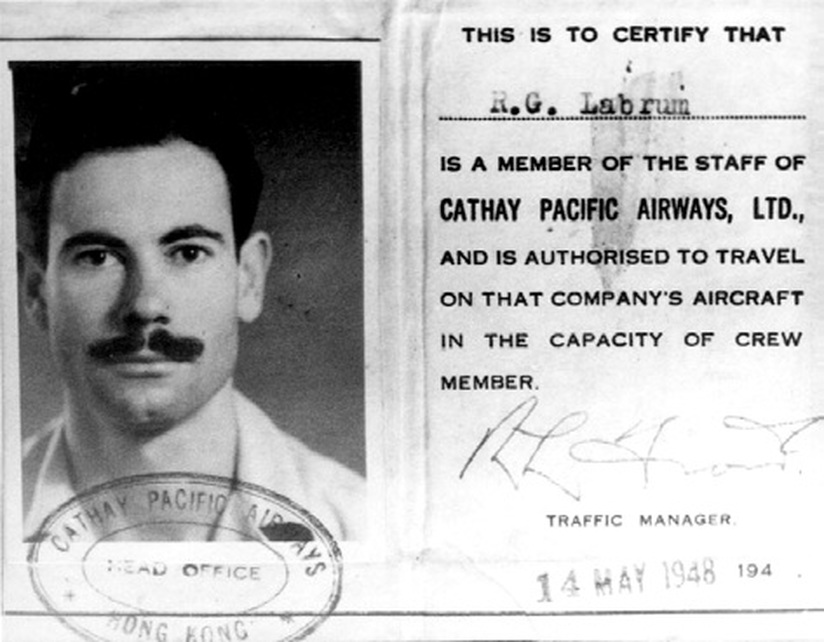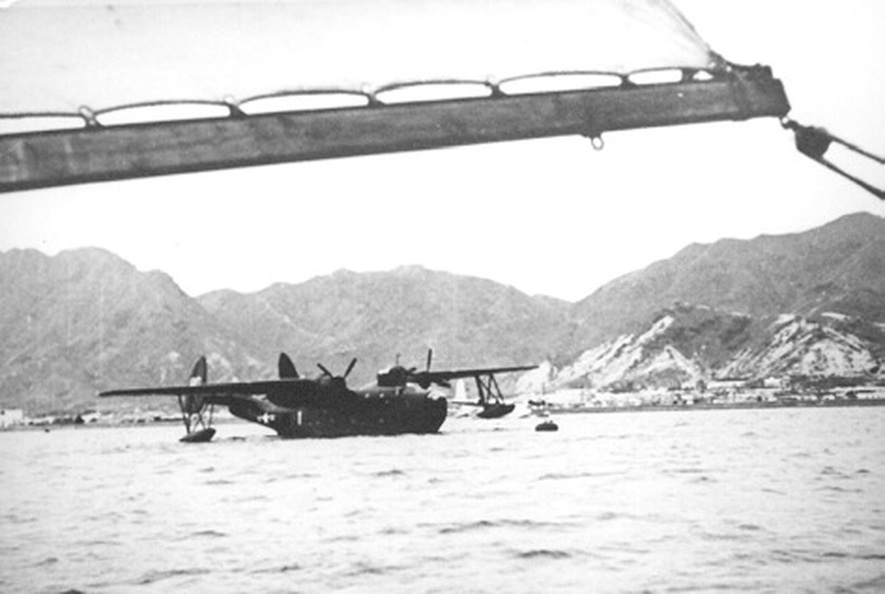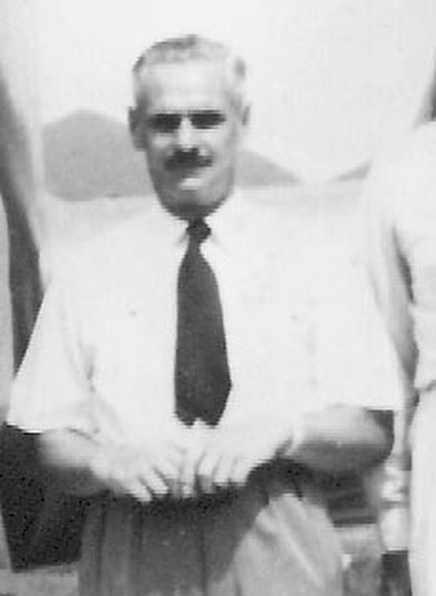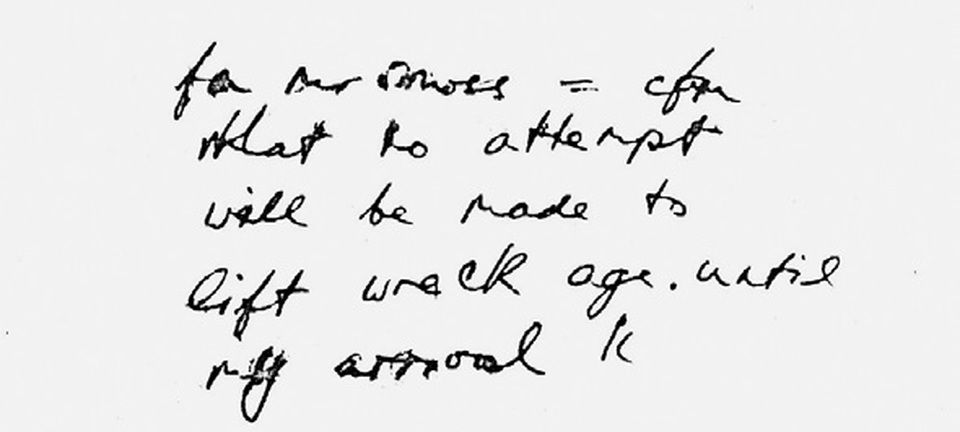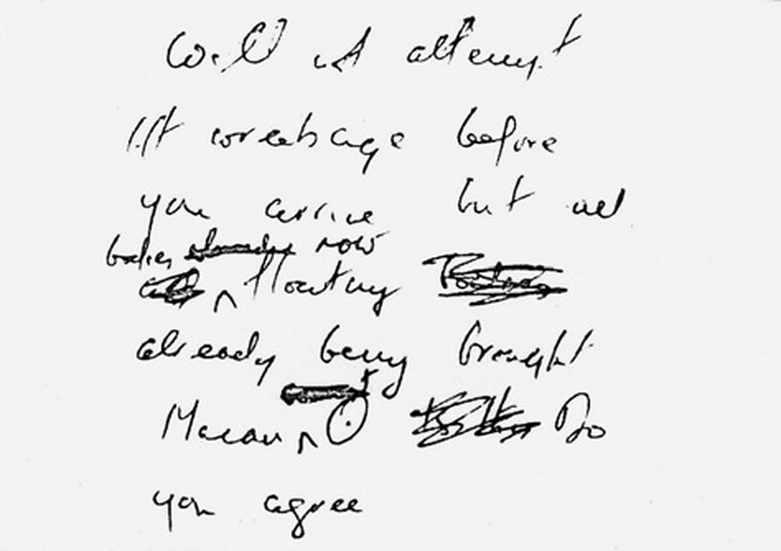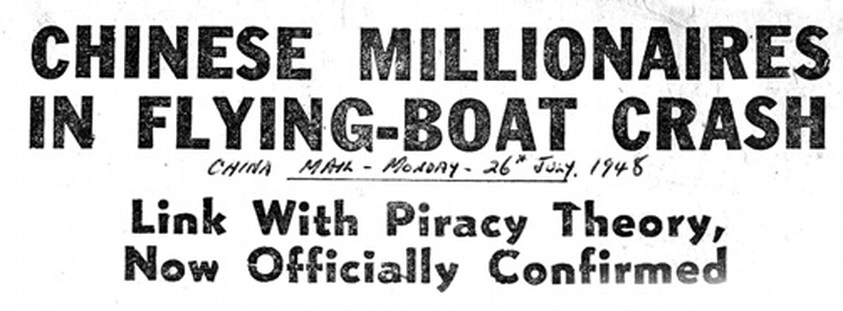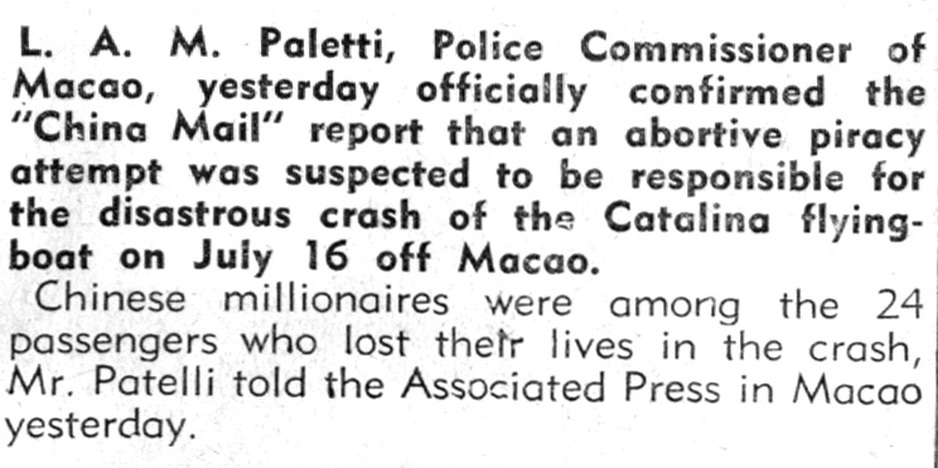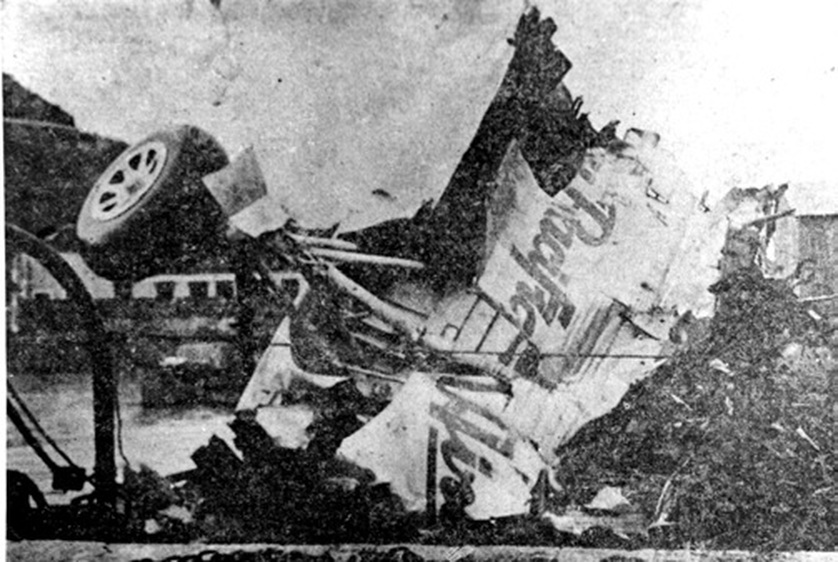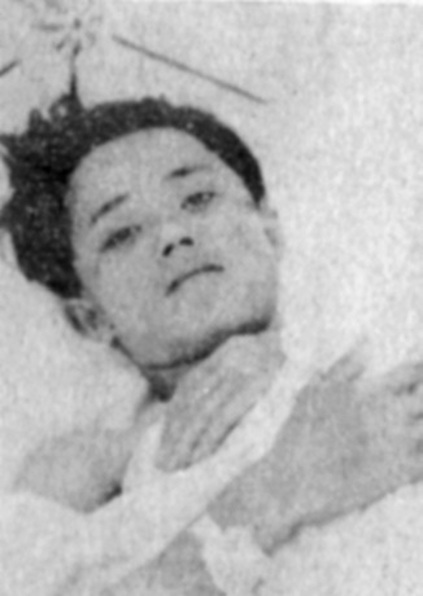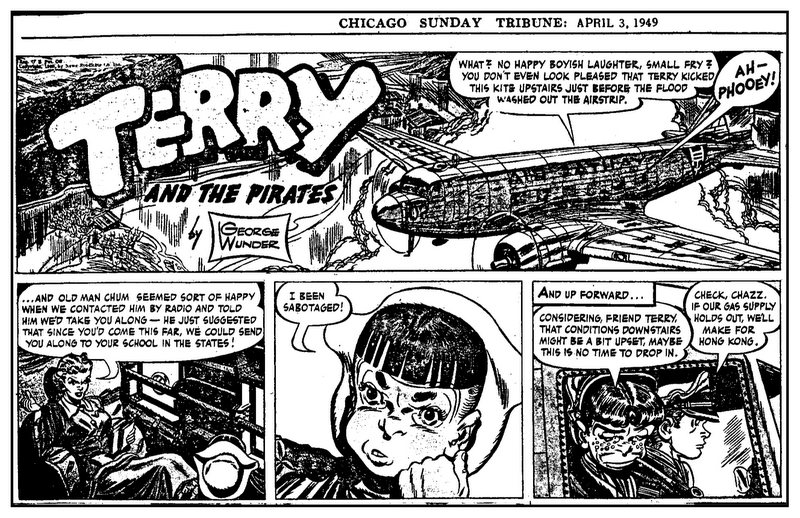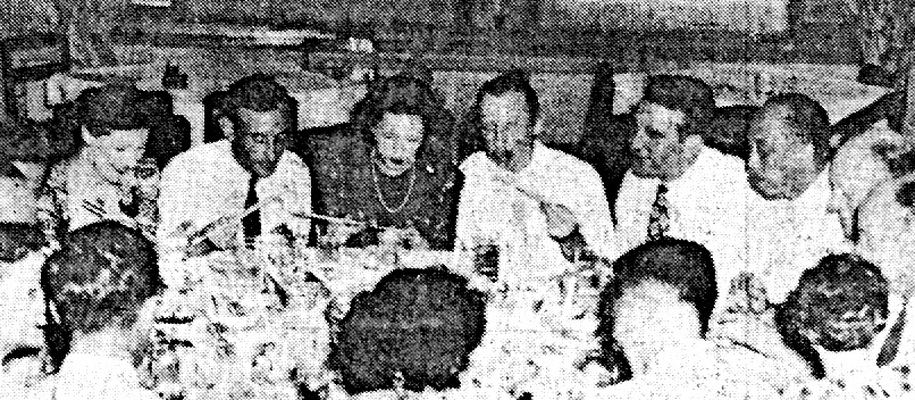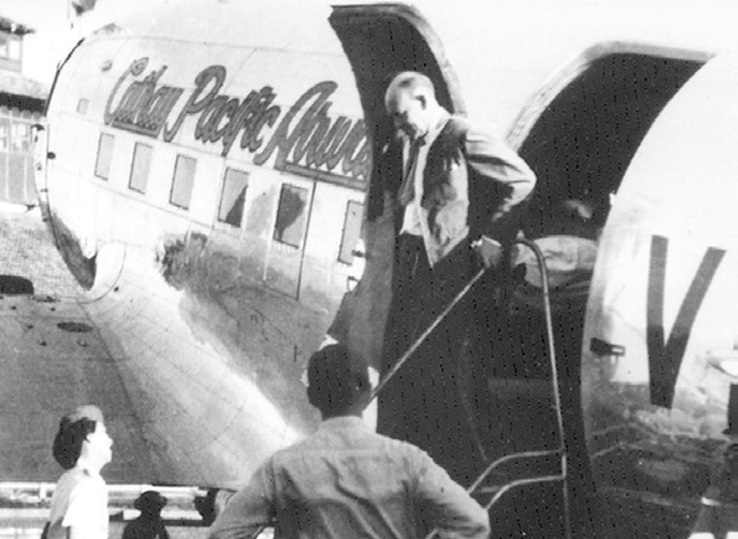Miss Macao Story
Extract from Chic's book Syd's Last Pirate
The Consolidated Vultee Aircraft Corporation of San Diego, California designed the Catalina as a pure flying boat for the US Navy in the early thirties. However, with the advent of World War 11 the Canadian Government, aware of the great work it did in its vast Northwest, built an amphibious version under licence and named it Canso, a name that is not well known except in Canada.
The Catalina proved a robust plane with remarkable endurance, which allowed QANTAS to maintain the air route between Koggala, Ceylon and Perth in Western Australia during the dark days of World War 11.
Between July 1943 and July 1945 QANTAS Catalinas made 271 crossings. The average time in the air was 27 hours with the longest of these 31 hours 51 minutes. QANTAS presented each passenger with a handsome certificate titled Secret Order of the Double Sunrise – proof of being airborne in excess of 24 hours. Those who wrestled with this hybrid knew it as the PBY or Pigboat. Some blessed it, many cursed it, and hundreds died in it – including my younger brother.
Roy Farrell and Syd de Kantzow bought their Catalina in September 1947 from the USAAF Federal Liquidation Commission in the Philippines. They got a steal for 6,000 pesos - about $HK 12,000, and safely negotiated the 600 miles of restless sea that separates the Philippine Island of Luzon from Mainland China. The then unregistered plane put down at Kai Tak during the late morning of 2 October 1947, and almost before the propellers stopped turning an army of engineering minions descended on her. With indecent haste they commenced to strip her, and with the remarkable engineering efficiency that Cathay Pacific commanded in those days, the passenger conversion was completed by late November. On 5 December she entered service with the registration VR-HDT. She seated 23 passengers and with just 993 hours on the clock she was a lovely and regal lady in youthful bloom.
The Catalina proved a robust plane with remarkable endurance, which allowed QANTAS to maintain the air route between Koggala, Ceylon and Perth in Western Australia during the dark days of World War 11.
Between July 1943 and July 1945 QANTAS Catalinas made 271 crossings. The average time in the air was 27 hours with the longest of these 31 hours 51 minutes. QANTAS presented each passenger with a handsome certificate titled Secret Order of the Double Sunrise – proof of being airborne in excess of 24 hours. Those who wrestled with this hybrid knew it as the PBY or Pigboat. Some blessed it, many cursed it, and hundreds died in it – including my younger brother.
Roy Farrell and Syd de Kantzow bought their Catalina in September 1947 from the USAAF Federal Liquidation Commission in the Philippines. They got a steal for 6,000 pesos - about $HK 12,000, and safely negotiated the 600 miles of restless sea that separates the Philippine Island of Luzon from Mainland China. The then unregistered plane put down at Kai Tak during the late morning of 2 October 1947, and almost before the propellers stopped turning an army of engineering minions descended on her. With indecent haste they commenced to strip her, and with the remarkable engineering efficiency that Cathay Pacific commanded in those days, the passenger conversion was completed by late November. On 5 December she entered service with the registration VR-HDT. She seated 23 passengers and with just 993 hours on the clock she was a lovely and regal lady in youthful bloom.
In her new civilian role the airline added an icebox for cold drinks - no other catering was necessary. So, for an outlay of about $HK 50,000 Cathay Pacific had an asset that was valued at $HK 173,400 when the Company restructured just six months later. Dubbed the Miss Macao she made her inaugural flight to Macau on 9 April 1948 under charter to the Macao Air Transport Company (MATCO).
On the 30 June 1948 I found my self crewed with Captain Dale Cramer, F/E Jack Williams, and R/O Alex Stewart. This was a Gold Charter from Hong Kong to Batavia via Macao. The next day we returned to Saigon where we stayed the night while the bank loaded the cargo of gold boxes.
On the 2 July Captain Cramer gave me the final sector from Macao to Kai Tak. My water take-off had an eminently forgettable flavour but my Kai Tak landing redeemed me as I greased her on! My skipper breathed a sigh of relief, the flight engineer grunted in a non-committal way and the radio officer broke into spontaneous applause. Obviously, the sparks had a more generous nature than the flight spanner. I remember that sector with clarity for it was the last time I saw Dale Cramer, - a fine American gentleman.
Miss Macao had logged a total of 1,596 hours when, on 16t July 1948, she became a muddied, twisted heap of corroding metal and the tomb of innocent people. With this metamorphosis she entered history, having become the victim in the world’s first air piracy, an attempted skyjack that went miserably wrong.
On the 2 July Captain Cramer gave me the final sector from Macao to Kai Tak. My water take-off had an eminently forgettable flavour but my Kai Tak landing redeemed me as I greased her on! My skipper breathed a sigh of relief, the flight engineer grunted in a non-committal way and the radio officer broke into spontaneous applause. Obviously, the sparks had a more generous nature than the flight spanner. I remember that sector with clarity for it was the last time I saw Dale Cramer, - a fine American gentleman.
Miss Macao had logged a total of 1,596 hours when, on 16t July 1948, she became a muddied, twisted heap of corroding metal and the tomb of innocent people. With this metamorphosis she entered history, having become the victim in the world’s first air piracy, an attempted skyjack that went miserably wrong.
The China coast shelters perhaps the last strongholds of the pirate scourge, with the possible exception of the Sea-Dyak lairs in Malaysia waters. The late twentieth century routine had a simple approach. The pirate band took passage as ordinary coolies on a steamer, and at a given signal they produced revolvers and captured the ship’s bridge. They then shot the junior officer and tossed his body to the fish as an example of their earnestness, after which they found little resistance to sailing the prize to their headquarters at Bias Bay. There they plundered the passengers and held the crew to ransom. Bias Bay is the modern Daya Wan, a bay east-north-east of Kowloon.
A famous incident occurred on 10 December 1890 when the Douglas Line’s S.S. Namoa was captured after clearing the waters of the Colony of Hong Kong. This was a shocking attack where Captain Pockcock was murdered and his officers shackled. The pirates then raped, looted and killed. The low yield of their loot enraged them to a brutality beyond belief, and a method used to disclose hidden loot was to jam a carpenter’s file between the victim’s teeth and work it with both hands.
On the 17 April 1891 the Chinese authorities brought several pirates to a Kowloon beach. There a group of Europeans witnessed as the executioner beheaded 16 pirates convicted of the Namoa atrocity. That beach fronted Kowloon City near the site that became the Airport of the Nine Dragons - Kai Tak Airport.
A famous incident occurred on 10 December 1890 when the Douglas Line’s S.S. Namoa was captured after clearing the waters of the Colony of Hong Kong. This was a shocking attack where Captain Pockcock was murdered and his officers shackled. The pirates then raped, looted and killed. The low yield of their loot enraged them to a brutality beyond belief, and a method used to disclose hidden loot was to jam a carpenter’s file between the victim’s teeth and work it with both hands.
On the 17 April 1891 the Chinese authorities brought several pirates to a Kowloon beach. There a group of Europeans witnessed as the executioner beheaded 16 pirates convicted of the Namoa atrocity. That beach fronted Kowloon City near the site that became the Airport of the Nine Dragons - Kai Tak Airport.
The plan for pirating the Miss Macao developed in the minds of Chio Tok, Chio Kei Mun and Chio Cheong, three villagers of Nam Mun, on the south east coast of Tao Mun Island. Their bankroll was $HK 3,000 gained from selling the family rice field. Tok, the leader, had learned to fly amphibians while living in Manila. The idea was for the gang to pay the normal passage fare and board in the usual way. Once airborne they would subdue the crew, allowing Tok to take over the controls. Although it was a straightforward plan Tok foresaw two weaknesses.
Kei Mun was an opium smoker with a habit costing three dollars a day and probably unreliable under pressure. The greater weakness was their lack of knowledge of the local coast or islands. Where would they take the captured Catalina?
To rectify this deficiency Tok approached Wong Yu, a 24 year old rice farmer who also lived on the island of Tao Mun. Wong knew the Seong Chao region like the back of his hand. He suggested several likely spots to land the plane that also were suitable for conducting hostage negotiations.
Wong Yu agreed to join the band, although he stipulated that he would take no part in the actual hold-up, doubtless reasoning that should the attack fail he could continue to Hong Kong as an ordinary passenger. His sole contribution would be to direct Tok to the most suitable landing site, also stipulating that he would not guard the captured passengers. Further, he astutely reminded Tok that any site they chose would lead to the locals blackmailing them to keep silent.
Both disturbed and influenced by Wong Yu’s many conditions Tok redrafted his plans and dismissed Kei Mun, but he kept Wong Yu in the scheme, perhaps as a precaution against betrayal, and enlisted a clansman from Sio Chek Kam, another village on Tao Mun.
Further, he amended the destination of the captured plane to his village of Nam Mun where the locals were family and more likely to keep their mouths shut. Several village conferences decided that after looting the Catalina they would abandon passengers and crew in the rugged mountains of Seong Chao. Leaving as little to chance as possible they made a dummy run to learn the procedures of MATCO, who chartered the Catalina from Cathay Pacific Airways.
Kei Mun was an opium smoker with a habit costing three dollars a day and probably unreliable under pressure. The greater weakness was their lack of knowledge of the local coast or islands. Where would they take the captured Catalina?
To rectify this deficiency Tok approached Wong Yu, a 24 year old rice farmer who also lived on the island of Tao Mun. Wong knew the Seong Chao region like the back of his hand. He suggested several likely spots to land the plane that also were suitable for conducting hostage negotiations.
Wong Yu agreed to join the band, although he stipulated that he would take no part in the actual hold-up, doubtless reasoning that should the attack fail he could continue to Hong Kong as an ordinary passenger. His sole contribution would be to direct Tok to the most suitable landing site, also stipulating that he would not guard the captured passengers. Further, he astutely reminded Tok that any site they chose would lead to the locals blackmailing them to keep silent.
Both disturbed and influenced by Wong Yu’s many conditions Tok redrafted his plans and dismissed Kei Mun, but he kept Wong Yu in the scheme, perhaps as a precaution against betrayal, and enlisted a clansman from Sio Chek Kam, another village on Tao Mun.
Further, he amended the destination of the captured plane to his village of Nam Mun where the locals were family and more likely to keep their mouths shut. Several village conferences decided that after looting the Catalina they would abandon passengers and crew in the rugged mountains of Seong Chao. Leaving as little to chance as possible they made a dummy run to learn the procedures of MATCO, who chartered the Catalina from Cathay Pacific Airways.
The gang’s base was the home of 29-year-old Chio Iek Chan, a pretty deserted wife living in a suburb of Macao at 39 Rua Coelho do Amaral. She was an honest woman with no criminal aspirations, in stark contrast to her 37-year-old sister Mm Vo, who was tall, thin and ugly with a well defined streak of larceny and the disposition of a Shrew. Mm Vo waited for a visa to join her husband in New York, but from her description it seemed a safe bet that he hoped the visa would get lost in the post.
A little after 09:30 hours on the morning of 16 July the gang gathered at Iek Chan’s house. After finishing the meal she provided they went shopping on the Avenida de Almeida Ribeiro for some lightweight European clothing. Before going Tok deposited a small bag in a chest of drawers.
He warned the sisters that they must not touch the bag, but this seemed a challenge to the unattractive Mm Vo. With trembling fingers she unzipped the bag and drew a breath of alarm as three hand guns tumbled out. Her agitation was so intense she had trouble re-zipping the bag.
The conspirators made their purchases at a cost of 20 patacas, had coffee at a small restaurant then returned to Iek Chan’s house to change into the newly purchased threads. Their spirits were buoyant but were impatient to get going! Mm Vo used a neighbour’s phone to arrange a taxi to take
the men to the sea-drome’s embarkation launch as fate closed the gap!
The conspirators made their purchases at a cost of 20 patacas, had coffee at a small restaurant then returned to Iek Chan’s house to change into the newly purchased threads. Their spirits were buoyant but were impatient to get going! Mm Vo used a neighbour’s phone to arrange a taxi to take
the men to the sea-drome’s embarkation launch as fate closed the gap!
Ensign Dale Warren Cramer began training at U.S.N.R.A.B Memphis, Tennessee on 30 January 1943 under 1st Lieutenant. Lipscomb. He soloed on 17 February on N25-307564. In April he moved to the naval station Corpus Christi, Texas and by July was flying Catalina PBYs. After logging 1000 hours he was posted to Patrol Squadron 45, and finished the war and his naval career with 1789 hours logged, leaving the service early in 1947. His record and ability earned him a captaincy with I.N.A.C.O. a Philippine Company that operated Catalina amphibians. In June Trans-Asiatic Air Service of Bangkok hired him to operate DC-3s. In August 1947 Cathay Pacific snapped him up when he applied for a job.
On the fateful afternoon he expected to take a passenger on the round trip. This was the great Alan Marshall a freelance journalist and the author of I can Jump Puddles. Since contracting polio at the age of six, Alan walked on crutches. Earlier he left his room in the Cathay Pacific crew mess at Kowloon where he had spent much time learning about aircrew. He listened with apparent interest to our thoughts and anecdotes, and our lies of sexual conquests. Alan accompanied the Miss Macao crew on the hair-raising car ride to Kai Tak, and was enjoying a beer in the airport lounge when the soft sweet voice of 2l year old hostess Delca da Costa broke through his reverie.
Captain Cramer has asked me to tell you it’s five o’clock. We expect to leave in a few minutes so may I help you out to the plane? Alan lined up his frosty beer-glass with the passenger steps located at the Catalina’s port blister. With trepidation he surveyed the intervening fifty yards of searing concrete and made an executive decision possibly the most important of his life.
Delca, dear, kindly tell Captain Dale that my legs are giving me more pain than usual. Please ask if may I have a rain check?
Before she could answer Alan’s companion interjected, Never mind, Delca, I’ll walk out with you and explain to the skipper. This was Cathay’s Sales and Traffic Officer - Bob Frost.
Bob had earlier confided to Alan that he was bored stiff. It seemed his new bride was having a perm that would take hours and he had decided that if there was an empty seat he would go along for the ride, but had found a full plane. So Alan’s cancellation meant he had a seat and for insurance purposes he listed himself as supernumerary crew.
On the fateful afternoon he expected to take a passenger on the round trip. This was the great Alan Marshall a freelance journalist and the author of I can Jump Puddles. Since contracting polio at the age of six, Alan walked on crutches. Earlier he left his room in the Cathay Pacific crew mess at Kowloon where he had spent much time learning about aircrew. He listened with apparent interest to our thoughts and anecdotes, and our lies of sexual conquests. Alan accompanied the Miss Macao crew on the hair-raising car ride to Kai Tak, and was enjoying a beer in the airport lounge when the soft sweet voice of 2l year old hostess Delca da Costa broke through his reverie.
Captain Cramer has asked me to tell you it’s five o’clock. We expect to leave in a few minutes so may I help you out to the plane? Alan lined up his frosty beer-glass with the passenger steps located at the Catalina’s port blister. With trepidation he surveyed the intervening fifty yards of searing concrete and made an executive decision possibly the most important of his life.
Delca, dear, kindly tell Captain Dale that my legs are giving me more pain than usual. Please ask if may I have a rain check?
Before she could answer Alan’s companion interjected, Never mind, Delca, I’ll walk out with you and explain to the skipper. This was Cathay’s Sales and Traffic Officer - Bob Frost.
Bob had earlier confided to Alan that he was bored stiff. It seemed his new bride was having a perm that would take hours and he had decided that if there was an empty seat he would go along for the ride, but had found a full plane. So Alan’s cancellation meant he had a seat and for insurance purposes he listed himself as supernumerary crew.
Robert Bob Lowich Frost was born in Australia in1921,and had a successful QANTAS association until Cathay Pacific wheedled him away from a cushy Singapore posting.
Just before 17:30 hours on 16 July 1948 Captain Cramer got taxi clearance from Kai Tak Tower. He lined up Miss Macao and did her engine check. Roy Downing cleared him for take-off. Cramer opened the throttles fully, his feet firm on the brake pedals. As the sound above his head reached a comfortable roar he released the brakes and Macao Flight Two was rolling on schedule. At 60 knots he lifted the nose-wheel off the concrete and at 75 solid back-pressure on the control yoke brought the Catalina into the air, On the call of Wheels Up his young first officer, Sydney-born 23-year-old Ken McDuff, selected the gear lever to up. The ponderous system took nearly two minutes to tuck the wheels into the hull in a semblance of streamlining.
Just before 17:30 hours on 16 July 1948 Captain Cramer got taxi clearance from Kai Tak Tower. He lined up Miss Macao and did her engine check. Roy Downing cleared him for take-off. Cramer opened the throttles fully, his feet firm on the brake pedals. As the sound above his head reached a comfortable roar he released the brakes and Macao Flight Two was rolling on schedule. At 60 knots he lifted the nose-wheel off the concrete and at 75 solid back-pressure on the control yoke brought the Catalina into the air, On the call of Wheels Up his young first officer, Sydney-born 23-year-old Ken McDuff, selected the gear lever to up. The ponderous system took nearly two minutes to tuck the wheels into the hull in a semblance of streamlining.
Most pilots believed the undercarriage system was the nightmarish design of Emmet of the magazine Punch, but surprisingly, it seldom failed. The nose wheel was its weakness having a tendency to lag and a judicious skipper would visually check the watertight doors were fully closed before making a water landing.
Duty controller Roy Downing recorded take-off at 5.30 p.m., and watched the Miss Macao flying out at 1000 feet on a track of about 275 true before gently turning to port around the northern tip of Lantau Island on the normal good-weather route. Levelled out, the Catalina quickly achieved its flight-planned airspeed of 130 knots, and with power reduced the passengers could maintain a shouted conversation, for soundproofing was a non-existent luxury. Lantau Island, eight miles from Hong Kong and flaunting a craggy peak of 3065 feet contributed to the limitation of radio contact between Hong Kong and Macao, a matter of great concern when any aircraft became overdue. First Officer McDuff advised Hong Kong they had Macao in sight and went off the air. This was normal procedure for the low operating height and the damping effect from Lantau Island prevented reception.
Duty controller Roy Downing recorded take-off at 5.30 p.m., and watched the Miss Macao flying out at 1000 feet on a track of about 275 true before gently turning to port around the northern tip of Lantau Island on the normal good-weather route. Levelled out, the Catalina quickly achieved its flight-planned airspeed of 130 knots, and with power reduced the passengers could maintain a shouted conversation, for soundproofing was a non-existent luxury. Lantau Island, eight miles from Hong Kong and flaunting a craggy peak of 3065 feet contributed to the limitation of radio contact between Hong Kong and Macao, a matter of great concern when any aircraft became overdue. First Officer McDuff advised Hong Kong they had Macao in sight and went off the air. This was normal procedure for the low operating height and the damping effect from Lantau Island prevented reception.
Without a normal landing field the Macao authorities decided a radio station was an unnecessary luxury. Therefore the MATCO amphibian skippers were free to make whatever arrangements they deemed necessary. Nor did the Government supply a launch to keep the landing ways clear of small craft and debris. The Enclave’s aviation financial support operated with the frugality of a shoelace with terminal anorexia.
Captain Cramer placed his reliance on one low-powered run over the breakwater-enclosed harbour to scatter the sampans. Normally a second such nudge was unnecessary for the experienced women scullers had begun to make way at the first sound of the Catalina’s engines. As they circled for the landing McDuff climbed into the engineer’s tower and hit the switch that lowered the floats from the wingtips, completing the transition to flying boat. The skipper gently closed the throttles and for the very last time settled Miss Macao sweetly onto Portuguese waters.
At the forward hatch McDuff completed the mooring procedure with a glow of pride. This was his best effort for not a drop of spray had sullied his freshly cleaned uniform. The reason McDuff was on that flight was the result of a mooring accident. The mornings flight’s first officer had tumbled into the muddy, stinking water when he had misjudged the pick-up. The reason Captain Cramer was on the flight was that Chief pilot Hunt had developed an acute earache on that morning’s flight. Such coincidences bring sobering thoughts.
Captain Cramer placed his reliance on one low-powered run over the breakwater-enclosed harbour to scatter the sampans. Normally a second such nudge was unnecessary for the experienced women scullers had begun to make way at the first sound of the Catalina’s engines. As they circled for the landing McDuff climbed into the engineer’s tower and hit the switch that lowered the floats from the wingtips, completing the transition to flying boat. The skipper gently closed the throttles and for the very last time settled Miss Macao sweetly onto Portuguese waters.
At the forward hatch McDuff completed the mooring procedure with a glow of pride. This was his best effort for not a drop of spray had sullied his freshly cleaned uniform. The reason McDuff was on that flight was the result of a mooring accident. The mornings flight’s first officer had tumbled into the muddy, stinking water when he had misjudged the pick-up. The reason Captain Cramer was on the flight was that Chief pilot Hunt had developed an acute earache on that morning’s flight. Such coincidences bring sobering thoughts.
With the passengers transferred to the launch, Delca da Costa settled herself on the lip of the blister, her ankles comfortably crossed. This was the coolest place during the turnaround that was made in record time, for the cabin heated to scorching within minutes. She used those few minutes to add a few more details of her Cathay life for Alan Marshall. Recently, Alan had contributed a successful article to Woman magazine and Delca’s story was the follow up.
Delca soon had the return passengers seated. McDuff closed the mooring hatch, reached through the window and removed the courtesy flag and stowed it, then strapped himself in the co-pilot’s seat. He was ready for his skipper’s pre-take-off check by holding the appropriate full aileron input. On land aircraft engines are individually run up or checked with brakes locked. However, operating on water, aircraft engines are individually run up as the aircraft turns in a circle. The plane circles to port when the right (starboard) engine is advanced and vice versa.
The test setting for the Catalina is 30 inches of mercury, and each dual magneto is tested in turn. The aileron input is opposite to the turn and the control column is held right back, so that if the aircraft is turning to port the right (starboard) aileron is wound right in. These two actions keep the wingtip floats from digging into a swell and help to tighten the turn, which is vital in a confined area. With an hour to go before low tide Cramer had ample depth of water, but with a slight wind, he must use every inch of space. A firm and continuous movement of his right hand opened the two overhead throttle levers. He nodded as McDuff's left hand followed up, holding the throttles in place against the wave-induced jarring. Precisely at this moment he rocked the wings to help bring the hull onto its planing step. The solid bow-wave gave way to a beautiful feathered wake, and the heavy spray that had blocked the passengers’ visibility gave
way to well-spaced bubbles.
Delca soon had the return passengers seated. McDuff closed the mooring hatch, reached through the window and removed the courtesy flag and stowed it, then strapped himself in the co-pilot’s seat. He was ready for his skipper’s pre-take-off check by holding the appropriate full aileron input. On land aircraft engines are individually run up or checked with brakes locked. However, operating on water, aircraft engines are individually run up as the aircraft turns in a circle. The plane circles to port when the right (starboard) engine is advanced and vice versa.
The test setting for the Catalina is 30 inches of mercury, and each dual magneto is tested in turn. The aileron input is opposite to the turn and the control column is held right back, so that if the aircraft is turning to port the right (starboard) aileron is wound right in. These two actions keep the wingtip floats from digging into a swell and help to tighten the turn, which is vital in a confined area. With an hour to go before low tide Cramer had ample depth of water, but with a slight wind, he must use every inch of space. A firm and continuous movement of his right hand opened the two overhead throttle levers. He nodded as McDuff's left hand followed up, holding the throttles in place against the wave-induced jarring. Precisely at this moment he rocked the wings to help bring the hull onto its planing step. The solid bow-wave gave way to a beautiful feathered wake, and the heavy spray that had blocked the passengers’ visibility gave
way to well-spaced bubbles.
Now airborne, Cramer put Miss Macao into a wide, shallow right turn, rolling her onto the Hong Kong heading. Soon the ramshackle buildings of the Chung San area of old Macao gave place to the muddy waters of the Pearl River estuary. As McDuff unfastened his seat belt to climb the engineer’s tower and raise the wing floats Tok and Cheong sprang to their feet. With his menacing gun backing his words Tok demanded that Cramer surrender the controls, but the skipper refused!
As suspense froze the dumbfounded passengers, Choi moved forward from the centre compartment with his gun drawn. As he ordered the passengers to the starboard side someone intervened. In the confusion McDuff saw an opportunity, grabbing the flagpole and striking Cheong with it. In alarm Cheong cannoned into Tok who pressed his gun’s trigger. The bullet took Cramer in the base of the skull. The roar of the gun was the panic signal for all three pirates to fire. Within seconds all 18 bullets were expended, and yet their terrified fingers kept clicking on empty magazines. The skipper’s lifeless body slumped over the controls and nosed the Miss Macao into a gut-wrenching dive.
Within a few heartbeats the plane was dashed to fragments as she struck the sullen swell below.
The tail, emblazoned with the Union Jack, protruded for a brief moment before the muddy maw of the Pearl River estuary swallowed it.
As suspense froze the dumbfounded passengers, Choi moved forward from the centre compartment with his gun drawn. As he ordered the passengers to the starboard side someone intervened. In the confusion McDuff saw an opportunity, grabbing the flagpole and striking Cheong with it. In alarm Cheong cannoned into Tok who pressed his gun’s trigger. The bullet took Cramer in the base of the skull. The roar of the gun was the panic signal for all three pirates to fire. Within seconds all 18 bullets were expended, and yet their terrified fingers kept clicking on empty magazines. The skipper’s lifeless body slumped over the controls and nosed the Miss Macao into a gut-wrenching dive.
Within a few heartbeats the plane was dashed to fragments as she struck the sullen swell below.
The tail, emblazoned with the Union Jack, protruded for a brief moment before the muddy maw of the Pearl River estuary swallowed it.
As flotsam floated to the surface 20 of the 21 aboard had surrendered their souls. The time was 18:08 hours Macao standard time in the position 22 deg. 14’ 28”N: 113 deg. 44’ 43”E, some ten miles northeast of Macao.
The lone survivor, Wong Yu was sucked out through the port blister and instinctively reached for a seat cushion bobbing nearby. Some time later a Macao motorised fishing junk owned by Fung Man Yau, bundled him aboard. He was admitted to Macao’s St Januario Hospital and treated for severe shock and a fractured leg.
The lone survivor, Wong Yu was sucked out through the port blister and instinctively reached for a seat cushion bobbing nearby. Some time later a Macao motorised fishing junk owned by Fung Man Yau, bundled him aboard. He was admitted to Macao’s St Januario Hospital and treated for severe shock and a fractured leg.
It came as no surprise that Hong Kong received neither landing nor departure signals from the Catalina, but when nothing was heard for some 45 minutes of Miss Macao’s scheduled departure, a now weary Roy Downing opened the International Distress frequency 116.1 Mcs. After repeated calls brought no result he reported the overdue plane to his senior air traffic officer. Ben Hewson rushed to Kai Tak where he alerted the Hong Kong Water Police and the Chinese Maritime Customs who contacted their patrol vessels. However, the evening darkened to a black moonless night and they reluctantly abandoned their search until first light next morning.
Sydney Chan, MATCO’s Macao representative, had watched the Catalina take off and settle on her course to Hong Kong. He packed up and when the telephone rang at 21:30 hours he was spending the evening in his favourite armchair. A police superintendent advised him that a fisherman had brought an unconscious male to hospital. The fisherman had not tarried at the hospital but had said he thought the injured man might be from an aeroplane he saw crash about 6 PM. near the Ninepins Islands.
This was Sydney’s first indication that the Miss Macao might not have completed her normal run. The superintendent added that he had nothing else to report for atmospherics had effected reception from his patrol boats.
Unmanly thoughts flashed through Sydney’s mind that hopefully, it was another airline involved, for several passed close to Macao en-route to Hong Kong. Stanley would spend a sleepless night for he couldn’t make phone or radio contact with his Hong Kong principals.
Sydney Chan, MATCO’s Macao representative, had watched the Catalina take off and settle on her course to Hong Kong. He packed up and when the telephone rang at 21:30 hours he was spending the evening in his favourite armchair. A police superintendent advised him that a fisherman had brought an unconscious male to hospital. The fisherman had not tarried at the hospital but had said he thought the injured man might be from an aeroplane he saw crash about 6 PM. near the Ninepins Islands.
This was Sydney’s first indication that the Miss Macao might not have completed her normal run. The superintendent added that he had nothing else to report for atmospherics had effected reception from his patrol boats.
Unmanly thoughts flashed through Sydney’s mind that hopefully, it was another airline involved, for several passed close to Macao en-route to Hong Kong. Stanley would spend a sleepless night for he couldn’t make phone or radio contact with his Hong Kong principals.
In Hong Kong, Syd de Kantzow phoned the crew of VR-HDS cancelling the flight to Saigon early the next morning. He told his chief pilot, Dick Hunt, that the Miss Macao was overdue and he would command the search flight. Dick Labrum would handle the radio while Neil Norquay would provide another pair of eyes in the co-pilot seat, and be available for his engineering skills. Syd de Kantzow elected to remain in the Colony coordinating information as it came to hand.
At the crack of dawn Hunt’s search plane landed in the Macao breakwater. Ponderously it waddled up the old PanAm ramp to be met by Sydney Chan who repeated the news gleaned from Fung Man Yau, the rescue fisherman. Fearing the worst, but hoping for a miracle, Captain Hunt left immediately, intent on a low reconnoitre of the suspected crash site.
After a time they found two sampans anchored in shallow water. The crews were frantically waving to attract attention so Hunt circled as low are he dared. They saw several bodies tied behind the sampans and assumed, incorrectly as it transpired, the sampans had pinpointed the wreckage.
Captain Hunt was forced to return to Macao when Dick Labrum couldn’t get a response to his radio messages. Without warning the radio atmospherics abated and signals began flashing between Macao and Hong Kong. Captain Hunt’s report moved expectations from hope to the obvious - the Miss Macao was down.
At the crack of dawn Hunt’s search plane landed in the Macao breakwater. Ponderously it waddled up the old PanAm ramp to be met by Sydney Chan who repeated the news gleaned from Fung Man Yau, the rescue fisherman. Fearing the worst, but hoping for a miracle, Captain Hunt left immediately, intent on a low reconnoitre of the suspected crash site.
After a time they found two sampans anchored in shallow water. The crews were frantically waving to attract attention so Hunt circled as low are he dared. They saw several bodies tied behind the sampans and assumed, incorrectly as it transpired, the sampans had pinpointed the wreckage.
Captain Hunt was forced to return to Macao when Dick Labrum couldn’t get a response to his radio messages. Without warning the radio atmospherics abated and signals began flashing between Macao and Hong Kong. Captain Hunt’s report moved expectations from hope to the obvious - the Miss Macao was down.
This realisation galvanised the Macao authorities into greater efforts. And they send a patrol car to bring fisherman Fung to headquarters for detailed questioning. However, Fung felt he had fulfilled his neighbourly obligation and returned to earning his livelihood. In the early afternoon the water police found the wayward man and unceremoniously took his boat under tow.
At Macao Fung repeated his story and arranged to take the police and a MATCO official to the exact crash site. The onset of darkness prevented immediate action so it was arranged for the next morning - Sunday.
Meanwhile, other planes had joined the search. A US Navy Martin Mariner whose crew was enjoying some R. & R. forsook the fleshpots of Wan Chai and hastened to help. Meanwhile, a RAF Short Sunderland flying boat commanded by Leonard Len Francis Cosgrove, who later would join CPA & MATCO, was searching the bays and sandbars adjacent to the missing plane’s track.
At Macao Fung repeated his story and arranged to take the police and a MATCO official to the exact crash site. The onset of darkness prevented immediate action so it was arranged for the next morning - Sunday.
Meanwhile, other planes had joined the search. A US Navy Martin Mariner whose crew was enjoying some R. & R. forsook the fleshpots of Wan Chai and hastened to help. Meanwhile, a RAF Short Sunderland flying boat commanded by Leonard Len Francis Cosgrove, who later would join CPA & MATCO, was searching the bays and sandbars adjacent to the missing plane’s track.
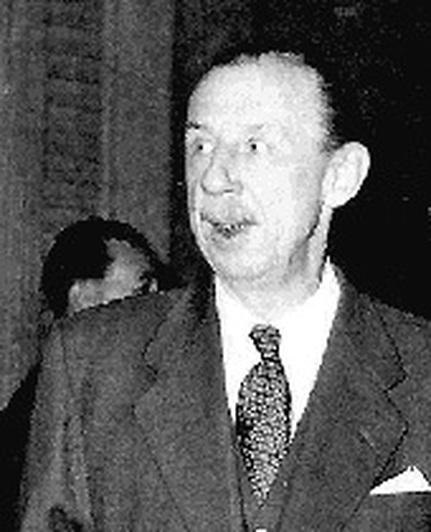
Mr. A.J.R. Papa Moss Hong Kong With the lengthening shadows Director of Civil Aviation, and Inspector of bringing that Saturday to a close, Accidents sustained a scratch during the salvage Captain Hunt returned VR-HDS to and was admitted to Queen Mary Hospital in Hong Kong where the media collared de Hong Kong with blood poisoning. Kantzow whom made these comments. (Report: SCMP 10 August 1948)
As the morning lengthened Captain Hunt returned to Hong Kong to pick up Papa Moss, Director of Civil Aviation, his chief signals officer Ben Hewson, and de Kantzow. Moss and Hewson accepted the invitation to establish a command post at Macao’s police headquarters.
With the lengthening shadows bringing that Saturday to a close, Captain Hunt returned VR-HDS to Hong Kong where the media collared de Kantzow whom made these comments. No accurate picture has emerged and stories circulating in Macao are conflicting. I have, however, received information that a submerged plane has been found and with the Miss Macao overdue I fear the worst. We expect to drag that area tomorrow morning.
From a different part of Macao the SS Merry Moller eased away from her mooring at 14:15 hours. Her skipper, Captain Blown, expected a normal cruise to Hong Kong. However, at 15:20 hours, just off the island of Ching Chao, one of the Ninepins islands, his lookout sighted a floating object to port. Capt. Blown was aware of the overdue plane and when it was swung aboard realised it was a wing float. The forward part was stoved in consistent with a crash, but of a more sinister nature he saw a neat round hole through the fairing. Surely this could only be a bullet hole! Captain Blown did not convey his thoughts to any member of his crew, and that evening after docking in Hong Kong he took the float to Police Headquarters for forensic examination.
An even more macabre discovery was made before nightfall when a search launch recovered a battered body a few yards from the Macao breakwater. The wallet found in the sodden clothing revealed that it belonged to Mr H.G. Stewart, a passenger listed on the Miss Macao.
The police launch slipped its lines in the false light of Sunday’s pre-dawn. Aboard were senior police and company representatives under the direction of a simple fisherman – Fung Man Yu. Endemic to Chinese boat people Fung had no hesitation in returning to the exact spot where he saw Miss Macao plunge into unmarked waters. The launch commander ordered a marker flag overboard and two policemen to guard the spot in the launch’s dingy. This may seem an unnecessary precaution and possibly too late. However, as the salvage gained pace rumours began circulating that bodies were found without clothing and personal valuables. Some had fingers hacked off with gruesome ferocity. Nothing official was ever mentioned but it is well known that many Chinese are opportunistic realists yet I have slipped ahead of the story!
With the lengthening shadows bringing that Saturday to a close, Captain Hunt returned VR-HDS to Hong Kong where the media collared de Kantzow whom made these comments. No accurate picture has emerged and stories circulating in Macao are conflicting. I have, however, received information that a submerged plane has been found and with the Miss Macao overdue I fear the worst. We expect to drag that area tomorrow morning.
From a different part of Macao the SS Merry Moller eased away from her mooring at 14:15 hours. Her skipper, Captain Blown, expected a normal cruise to Hong Kong. However, at 15:20 hours, just off the island of Ching Chao, one of the Ninepins islands, his lookout sighted a floating object to port. Capt. Blown was aware of the overdue plane and when it was swung aboard realised it was a wing float. The forward part was stoved in consistent with a crash, but of a more sinister nature he saw a neat round hole through the fairing. Surely this could only be a bullet hole! Captain Blown did not convey his thoughts to any member of his crew, and that evening after docking in Hong Kong he took the float to Police Headquarters for forensic examination.
An even more macabre discovery was made before nightfall when a search launch recovered a battered body a few yards from the Macao breakwater. The wallet found in the sodden clothing revealed that it belonged to Mr H.G. Stewart, a passenger listed on the Miss Macao.
The police launch slipped its lines in the false light of Sunday’s pre-dawn. Aboard were senior police and company representatives under the direction of a simple fisherman – Fung Man Yu. Endemic to Chinese boat people Fung had no hesitation in returning to the exact spot where he saw Miss Macao plunge into unmarked waters. The launch commander ordered a marker flag overboard and two policemen to guard the spot in the launch’s dingy. This may seem an unnecessary precaution and possibly too late. However, as the salvage gained pace rumours began circulating that bodies were found without clothing and personal valuables. Some had fingers hacked off with gruesome ferocity. Nothing official was ever mentioned but it is well known that many Chinese are opportunistic realists yet I have slipped ahead of the story!
The police launch hastened back to Macao where by late morning an armada of fishing junks with dragging gear descended on the flagged area. Fisherman Fung’s information proved correct. By early evening an efficient and methodical quartering had pinpointed a section of the Miss Macao lying in four fathoms of water. Meanwhile, VR-HDS had returned from Hong Kong to support the salvage team. Captain de Kantzow and Farrell came to representCathay Pacific, MATCO’s Roger Lobo came to watch his company’s interest while engineer Larry Cabot, Dale Cramer’s boon mate, came to assist as required.
A crane-barge towed to the site formed both a natural command post and a protected anchorage for VR-HDS. For several days the Catalina shuttled between Hong Kong and Macao dispensing information and bringing principals to the scene. Though the wind frequently made the sea unstable Dick Labrum’s expertise kept the station on line. Carefully stowed in the back of his logbook are these memorable snippets of an evil event that caught the attention of the civilised world. They are copied in a hand shaking with emotion. The first was a message from Mr A.J.R. Papa Moss the Hong Kong Director of Civil Aviation that translates;
`Confirm that no attempt will be made to lift wreckage until my arrival.’
Captain. de Kantzow responded - `Will not attempt to lift wreckage before you arrive, but all bodies now floating being sent Macao. Do you agree?’ One hoped that Papa Moss did not object, for decomposing bodies disturbed by the salvage kept popping to the surface.
A crane-barge towed to the site formed both a natural command post and a protected anchorage for VR-HDS. For several days the Catalina shuttled between Hong Kong and Macao dispensing information and bringing principals to the scene. Though the wind frequently made the sea unstable Dick Labrum’s expertise kept the station on line. Carefully stowed in the back of his logbook are these memorable snippets of an evil event that caught the attention of the civilised world. They are copied in a hand shaking with emotion. The first was a message from Mr A.J.R. Papa Moss the Hong Kong Director of Civil Aviation that translates;
`Confirm that no attempt will be made to lift wreckage until my arrival.’
Captain. de Kantzow responded - `Will not attempt to lift wreckage before you arrive, but all bodies now floating being sent Macao. Do you agree?’ One hoped that Papa Moss did not object, for decomposing bodies disturbed by the salvage kept popping to the surface.
In a period when Dick Labrum was having difficulty with reception a cruiser of the Chinese Maritime Customs came alongside the barge. The skipper agreed to make it a temporary radio station for it had greater stability than the bobbing Catalina. Yet, his radio equipment proved less successful than the Catalina’s equipment and the skipper decided to leave. In doing so he ran across some important markers that set the salvage back for several hours.
So far the sole survivor, Wong Yu, had contributed little to an explanation of the tragedy. Most of the time his speech was incoherent. All the investigators had gathered was that there was an explosion and he had jumped as the plane hit the water.
As the days ticked by fewer bodies were recovered, and of those marine life had made feature identification impossible. It was a trial to be near a body bloated with intestinal gases when the hot sun caused it to explode. The stench was appalling - further proof there is little dignity in a death by violence.
With little concrete news the media reverted to their stand-by fare – rumours. They were fanciful and as thick as fleas on a mangy dog. One alleged a man who worked for a Macao bullion firm was carrying 3000 taels of gold, which is 244 pounds or nearly 99 kilos! This man had exceptional strength! Another stated that looters had discovered the wreck ahead of the salvage team and stripped and looted the bodies. Another reported the sudden death of the only survivor Wong Yu. Most of the other rumours were obviously paragraph fillers and unworthy of further mention. Yet, the China Mail of 22 July 1948 caused a stir with its banner headline ABORTIVE PIRACY CAUSED CPA PLANE WRECK? This was the first allegation of any criminal intent and stirred the pot with the statement that three bodies continued to elude identification.
A typhoon (tiffy), summer scourge of the China Sea, decided to complicate the tricky salvage operation. However, at the crack of dawn on 25 July an armada of heavy lifting equipment and searchers had congregated on the marker flags that the tiffy had left intact. Roger, now Sir Roger Lobo recalls,
In the early part of the search the dragging nets had snagged several large parts of wreckage and these were flagged. Yet, nothing had been recovered from the sea. Now smaller parts, scattered over a wide area, were eluding our search. Exceptionally strong currents were adding to our woes and for hours we drifted aimlessly.
Then Roy Farrell, who was a great thinker, decided we should make soundings. He issued each of us with a length of string (Roy Downing says piano wire) ending in a metal weight and dragged it until we hit a hard obstruction. Then everyone gathered in that area repeating the exercise. When we were satisfied we sent down our divers. Those poor fellows had a terrible time, for the estuary bottom had no firm foothold and they slithered in waist deep evil sucking mud. Yet, Roy’s system produced splendid results and we salvaged many wayward pieces. Regretfully, some of them held entombed victims. Having lain in tropical salt water for a considerable period the bodies deteriorated rapidly, and the smell was overpowering.
Roy Farrell again came to their rescue by producing sanitary towels, sprinkled with Dettol, that he strapped around their noses. Dick Labrum recalls that it helped them put up with the smell more easily than before.
As the days ticked by fewer bodies were recovered, and of those marine life had made feature identification impossible. It was a trial to be near a body bloated with intestinal gases when the hot sun caused it to explode. The stench was appalling - further proof there is little dignity in a death by violence.
With little concrete news the media reverted to their stand-by fare – rumours. They were fanciful and as thick as fleas on a mangy dog. One alleged a man who worked for a Macao bullion firm was carrying 3000 taels of gold, which is 244 pounds or nearly 99 kilos! This man had exceptional strength! Another stated that looters had discovered the wreck ahead of the salvage team and stripped and looted the bodies. Another reported the sudden death of the only survivor Wong Yu. Most of the other rumours were obviously paragraph fillers and unworthy of further mention. Yet, the China Mail of 22 July 1948 caused a stir with its banner headline ABORTIVE PIRACY CAUSED CPA PLANE WRECK? This was the first allegation of any criminal intent and stirred the pot with the statement that three bodies continued to elude identification.
A typhoon (tiffy), summer scourge of the China Sea, decided to complicate the tricky salvage operation. However, at the crack of dawn on 25 July an armada of heavy lifting equipment and searchers had congregated on the marker flags that the tiffy had left intact. Roger, now Sir Roger Lobo recalls,
In the early part of the search the dragging nets had snagged several large parts of wreckage and these were flagged. Yet, nothing had been recovered from the sea. Now smaller parts, scattered over a wide area, were eluding our search. Exceptionally strong currents were adding to our woes and for hours we drifted aimlessly.
Then Roy Farrell, who was a great thinker, decided we should make soundings. He issued each of us with a length of string (Roy Downing says piano wire) ending in a metal weight and dragged it until we hit a hard obstruction. Then everyone gathered in that area repeating the exercise. When we were satisfied we sent down our divers. Those poor fellows had a terrible time, for the estuary bottom had no firm foothold and they slithered in waist deep evil sucking mud. Yet, Roy’s system produced splendid results and we salvaged many wayward pieces. Regretfully, some of them held entombed victims. Having lain in tropical salt water for a considerable period the bodies deteriorated rapidly, and the smell was overpowering.
Roy Farrell again came to their rescue by producing sanitary towels, sprinkled with Dettol, that he strapped around their noses. Dick Labrum recalls that it helped them put up with the smell more easily than before.
By midday of the 26 July most of the Miss Macao’s remains were under heavy police guard at Macao’s Naval Base. The China Mail, of that date carried the dramatic headline CHINESE MILLIONAIRES IN FLYING-BOAT CRASH, followed by the more pertinent Link With Piracy Theory, Now Officially Confirmed.
Macao Police Commissioner Captain Luis Augusto de Matos Paletti went on to say that four men and two women were helping the Macao police with their investigations. The two women were arrested when they visited the mortuary to identify the bodies of Wong’s three accomplices. Following intense interrogation two of the male suspects were subsequently released.
At the Macao Naval Yard the atmosphere became electric as the investigators lifted Miss Macao’s twisted hull from the barge a .38 calibre shell-case clattered to the concrete. Just as the investigation was gaining pace again nature intervened as another violent spell of weather hit the Enclave and prevented further dismantling of the wreckage until Thursday 29.
That day’s issue of S.C.M.P. removed any doubt that attempted piracy caused the Catalina crash. The article rehashed the sequence of events that destroyed the Miss Macao and published a photo of the pitiful remains of the once graceful plane.
Macao Police Commissioner Captain Luis Augusto de Matos Paletti went on to say that four men and two women were helping the Macao police with their investigations. The two women were arrested when they visited the mortuary to identify the bodies of Wong’s three accomplices. Following intense interrogation two of the male suspects were subsequently released.
At the Macao Naval Yard the atmosphere became electric as the investigators lifted Miss Macao’s twisted hull from the barge a .38 calibre shell-case clattered to the concrete. Just as the investigation was gaining pace again nature intervened as another violent spell of weather hit the Enclave and prevented further dismantling of the wreckage until Thursday 29.
That day’s issue of S.C.M.P. removed any doubt that attempted piracy caused the Catalina crash. The article rehashed the sequence of events that destroyed the Miss Macao and published a photo of the pitiful remains of the once graceful plane.
Under post mortem the bodies disclosed bullet wounds some with entry and exit points that showed firing at close range. A deep wound across Ken McDuff’s neck was deemed to have killed him.
Although confronted with this evidence and the bullet casings found as mud was washed from the wreck, Wong Yu, still refused to talk. Police Commissioner Captain Paletti mounted an entrapment and during a contrived medical procedure, Wong Yu’s room was bugged with a recording device. Paletti, who seemed to think on the level of those he hunted, enlisted the aid of a Macanese gangster as his agent provocateur.
This gangster was known throughout the Enclave as a determined enforcer who ran his empire with an iron hand. What was not general knowledge was his contempt for pirates, for in his view such scum lowered the tone of his profession.
Late one evening the gangster was brought into Wong Yu’s ward groaning and moaning from the surgery that had removed an imaginary bullet from his upper arm. To add realism and a relaxed family atmosphere the gangster’s relatives visited. Soon, Wong Yu, apparently finding a kindred spirit, began to brag of his part in the abortive Miss Macao scheme, and the cunning Captain Paletti had his confession!
The China Mail kept the incident in the public eye, stating that four Chinese millionaires were on the plane. The wife of one was carrying $US 500,000. The body Wong Chung-Ping, whose personal fortune was estimated at $US 3,000,000 had not been recovered, and neither had that of the plane’s commander Dale Cramer.
Captain Paletti went on record with the statement that there was no legislation covering piracy in the air and he was in a quandary of what charges Wong Yu would face.
Meanwhile the SCMP printed a letter attributed to Mr. C.W.L. Way whose insight-anticipated procedures adopted in later years. His suggestion was a low priced army mine detector that a single person could use to detect guns and other offensive weapons. He added there were thousands lying idle in war disposal stores throughout the United Kingdom.
On a lighter note and with no disrespect I include a popular comic strip of the day that seemed to slot into the current events, especially as the aeroplane carries the logo Air Cathay. Although, published in Chicago, hundreds in Hong Kong read it with avid enjoyment.
Although confronted with this evidence and the bullet casings found as mud was washed from the wreck, Wong Yu, still refused to talk. Police Commissioner Captain Paletti mounted an entrapment and during a contrived medical procedure, Wong Yu’s room was bugged with a recording device. Paletti, who seemed to think on the level of those he hunted, enlisted the aid of a Macanese gangster as his agent provocateur.
This gangster was known throughout the Enclave as a determined enforcer who ran his empire with an iron hand. What was not general knowledge was his contempt for pirates, for in his view such scum lowered the tone of his profession.
Late one evening the gangster was brought into Wong Yu’s ward groaning and moaning from the surgery that had removed an imaginary bullet from his upper arm. To add realism and a relaxed family atmosphere the gangster’s relatives visited. Soon, Wong Yu, apparently finding a kindred spirit, began to brag of his part in the abortive Miss Macao scheme, and the cunning Captain Paletti had his confession!
The China Mail kept the incident in the public eye, stating that four Chinese millionaires were on the plane. The wife of one was carrying $US 500,000. The body Wong Chung-Ping, whose personal fortune was estimated at $US 3,000,000 had not been recovered, and neither had that of the plane’s commander Dale Cramer.
Captain Paletti went on record with the statement that there was no legislation covering piracy in the air and he was in a quandary of what charges Wong Yu would face.
Meanwhile the SCMP printed a letter attributed to Mr. C.W.L. Way whose insight-anticipated procedures adopted in later years. His suggestion was a low priced army mine detector that a single person could use to detect guns and other offensive weapons. He added there were thousands lying idle in war disposal stores throughout the United Kingdom.
On a lighter note and with no disrespect I include a popular comic strip of the day that seemed to slot into the current events, especially as the aeroplane carries the logo Air Cathay. Although, published in Chicago, hundreds in Hong Kong read it with avid enjoyment.
Sydney de Kantzow’s official statement covered some lesser points.
On the afternoon of the day following the disaster we at CPA became suspicious of the circumstances surrounding the plane’s disappearance. We appointed private investigators in Macao to enquire into the bona fides of each passenger. By the Sunday the investigators had obtained sufficient evidence to bring in the Macao police. The pirate pilot carried, concealed in the heels of his shoes, bullets for use in the hold-up. When the actual hold-up occurred, a passenger offered resistance. In the struggle that followed shots were fired at the pilots. Frost must have become involved in the melee - as a member of the crew he would be seated in the forward compartment.
So far ten bodies have been picked up including three pirates. The body of the pirate pilot was recovered almost at the outset. One of the millionaire passengers was a retired gangster, and a bit of a fighter, his body was found with a bullet-hole clean through from chest to back.
The plane must have turned right round and dived into the sea at a very steep angle, the impact tearing off the nose. The force of the water, under extreme pressure, rushed through the fuselage and tore away the tail. In all probabilities it flushed out the sole survivor Wong Yu who was at the back of the plane. Only the middle part of the fuselage, the nose and a small section of the wing have been recovered. Still missing are the tail, the engines, most of the wing and the portion where the presumed fight took place.
The engineers’ reports showed the aircraft controls, instruments, mixture controls and switches were in normal cruise position. No fire had occurred. A gang tried to take Wong Yu away by suggesting he would be better in a private hospital. Wong twice attempted suicide in hospital.
Captain de Kantzow’s closing stated that the only solution to the new pirate hazard was the installation of metal detectors at departure points. Furthermore, he dismissed as impractical the suggestion of locking the crew door.
On the afternoon of the day following the disaster we at CPA became suspicious of the circumstances surrounding the plane’s disappearance. We appointed private investigators in Macao to enquire into the bona fides of each passenger. By the Sunday the investigators had obtained sufficient evidence to bring in the Macao police. The pirate pilot carried, concealed in the heels of his shoes, bullets for use in the hold-up. When the actual hold-up occurred, a passenger offered resistance. In the struggle that followed shots were fired at the pilots. Frost must have become involved in the melee - as a member of the crew he would be seated in the forward compartment.
So far ten bodies have been picked up including three pirates. The body of the pirate pilot was recovered almost at the outset. One of the millionaire passengers was a retired gangster, and a bit of a fighter, his body was found with a bullet-hole clean through from chest to back.
The plane must have turned right round and dived into the sea at a very steep angle, the impact tearing off the nose. The force of the water, under extreme pressure, rushed through the fuselage and tore away the tail. In all probabilities it flushed out the sole survivor Wong Yu who was at the back of the plane. Only the middle part of the fuselage, the nose and a small section of the wing have been recovered. Still missing are the tail, the engines, most of the wing and the portion where the presumed fight took place.
The engineers’ reports showed the aircraft controls, instruments, mixture controls and switches were in normal cruise position. No fire had occurred. A gang tried to take Wong Yu away by suggesting he would be better in a private hospital. Wong twice attempted suicide in hospital.
Captain de Kantzow’s closing stated that the only solution to the new pirate hazard was the installation of metal detectors at departure points. Furthermore, he dismissed as impractical the suggestion of locking the crew door.
I agree with both these statements. Metal detectors will go a long way to sift out many of the weapons of force. As for the impracticability of locking crew doors - the flight deck is connected by interphone at several cabin attendants’ points. How could a commander ignore the plight of an innocent person, threatened with slaughter, and keep his crew door locked. This is not the function of a commander whose prime duty is to protect each and every life placed in his or her care.
On the 10 September 1948 Cathay Pacific and MATCO hosted a banquet for Macao Police Commissioner Captain Luis Augusto de Matos Paletti in appreciation of the way he handled the inquiry. The host’s only ambition was that the captain should enjoy his meal but in short order they had their guest of honour singing for his supper.
Captain Luis Paletti disclosed that the sisters Chio Iek Chan and Chio Mm Vo fully co-operated with the investigative officers and their evidence, combined with the clothes taken from the pirate’s bodies clinched the guilt of Mm Vo as an accomplice.
Although Wong Yu’s evidence, obtained under entrapment, clearly disclosed he was an active participant, he continued to maintain he had an insignificant part in the crime. We can only ponder just how insignificant as nobody was in a position to contradict him! Furthermore, his eyewitness claims were without foundation. Seated as he was near the rear port loading blister several bulkheads blocked his forward view, and even if he moved into the aisle his view was little better.
A talking point at this dinner canvassed the question of who offered resistance. The European element gave the distinction to Mr H.M.R. Hodgman, a former Major of the Royal Corps of Signals and a noted Hong Kong jockey. The Chinese voted that it was the millionaire ex-gangster who would resent being victimised by amateur hatchet men as the loss of face would be appalling. Finally, the air fraternity gave the credit directly to Captain Dale Cramer. Fortunately, this tasteless and unproductive speculation ended and the night was a success.
As late as September 1948 Wong Yu was expected to face a Macao Tribunal at the Loyal Senate. In October Police Commissioner Captain Paletti, who doubled as Chief of the Colonial Governor’s Cabinet, informed the Hong Kong Police Commissioner they were ready to hand over the self-confessed air pirate Wong Yu for trial. Paletti told the media he thought the charge might be one of murder and stated that the Macao Court had found itself incompetent to try the matter, presumably deciding it had no jurisdiction over a crime committed on a British plane in International Waters.
On the 10 September 1948 Cathay Pacific and MATCO hosted a banquet for Macao Police Commissioner Captain Luis Augusto de Matos Paletti in appreciation of the way he handled the inquiry. The host’s only ambition was that the captain should enjoy his meal but in short order they had their guest of honour singing for his supper.
Captain Luis Paletti disclosed that the sisters Chio Iek Chan and Chio Mm Vo fully co-operated with the investigative officers and their evidence, combined with the clothes taken from the pirate’s bodies clinched the guilt of Mm Vo as an accomplice.
Although Wong Yu’s evidence, obtained under entrapment, clearly disclosed he was an active participant, he continued to maintain he had an insignificant part in the crime. We can only ponder just how insignificant as nobody was in a position to contradict him! Furthermore, his eyewitness claims were without foundation. Seated as he was near the rear port loading blister several bulkheads blocked his forward view, and even if he moved into the aisle his view was little better.
A talking point at this dinner canvassed the question of who offered resistance. The European element gave the distinction to Mr H.M.R. Hodgman, a former Major of the Royal Corps of Signals and a noted Hong Kong jockey. The Chinese voted that it was the millionaire ex-gangster who would resent being victimised by amateur hatchet men as the loss of face would be appalling. Finally, the air fraternity gave the credit directly to Captain Dale Cramer. Fortunately, this tasteless and unproductive speculation ended and the night was a success.
As late as September 1948 Wong Yu was expected to face a Macao Tribunal at the Loyal Senate. In October Police Commissioner Captain Paletti, who doubled as Chief of the Colonial Governor’s Cabinet, informed the Hong Kong Police Commissioner they were ready to hand over the self-confessed air pirate Wong Yu for trial. Paletti told the media he thought the charge might be one of murder and stated that the Macao Court had found itself incompetent to try the matter, presumably deciding it had no jurisdiction over a crime committed on a British plane in International Waters.
However, in Hong Kong the Attorney General expressed the opinion that there was no admissible evidence to prosecute in the British Crown Colony. He asked the Portuguese authorities to reconsider its decision.
On 11 June 1951 Wong Yu was released from prison where he had spent three years without a trial. He went to China where rumour had it his life was snuffed out in a suitably contrived accident, for the Chinese authorities detest piracy whether on sea, on land, or in the air.
What was the fate of the other participants in this sad affair? Mm Vo served several years in a Macao jail, and one ponders if she ever received her State Side visa – unlikely!
F/O Ken McDuff was interred in the Happy Valley cemetery. The evil cloying mud of the Pearl River kept the bodies of Captain Dale Cramer, A/H Delca da Costa, Bob Frost and nine other innocent victims.
Mr Tom Bax replaced Bob Frost as Sales and Traffic manager. As an aside, Tom was a boon friend of Bob Wawn. They had met as fellow prisoners in the notorious Sagen prisoner-of-war camp where the Germans murdered 50 British officers in 1944.
The Hong Kong Standard of 8 August 1948 reported that wreaths were dropped at the scene of the Cathay Pacific crash. Aboard were relatives of those lost and representative of MATCO and Cathay Pacific. A few days later the Macao service was resumed with Catalina VR-HDS.
This was the first incident of piracy in the air and for many years I grouped all skyjacks in this category. On 25 March 1972 a letter brought a request from David Phillips, a producer with Independent News, London. David had published a book on the subject called Leila’s Hi-Jack War, and sought details of the Miss Macao affair. His letter stated,
`The Miss Macao affair was the first skyjack carried out by a gang for criminal gain. The seven that preceded it had political motivation.’
On 11 June 1951 Wong Yu was released from prison where he had spent three years without a trial. He went to China where rumour had it his life was snuffed out in a suitably contrived accident, for the Chinese authorities detest piracy whether on sea, on land, or in the air.
What was the fate of the other participants in this sad affair? Mm Vo served several years in a Macao jail, and one ponders if she ever received her State Side visa – unlikely!
F/O Ken McDuff was interred in the Happy Valley cemetery. The evil cloying mud of the Pearl River kept the bodies of Captain Dale Cramer, A/H Delca da Costa, Bob Frost and nine other innocent victims.
Mr Tom Bax replaced Bob Frost as Sales and Traffic manager. As an aside, Tom was a boon friend of Bob Wawn. They had met as fellow prisoners in the notorious Sagen prisoner-of-war camp where the Germans murdered 50 British officers in 1944.
The Hong Kong Standard of 8 August 1948 reported that wreaths were dropped at the scene of the Cathay Pacific crash. Aboard were relatives of those lost and representative of MATCO and Cathay Pacific. A few days later the Macao service was resumed with Catalina VR-HDS.
This was the first incident of piracy in the air and for many years I grouped all skyjacks in this category. On 25 March 1972 a letter brought a request from David Phillips, a producer with Independent News, London. David had published a book on the subject called Leila’s Hi-Jack War, and sought details of the Miss Macao affair. His letter stated,
`The Miss Macao affair was the first skyjack carried out by a gang for criminal gain. The seven that preceded it had political motivation.’

